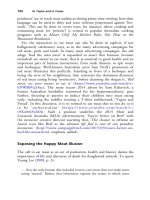The palgrave international handbook of a 230
Bạn đang xem bản rút gọn của tài liệu. Xem và tải ngay bản đầy đủ của tài liệu tại đây (28.4 KB, 1 trang )
International Trade in Animals and Animal Parts
225
and as companion animals. There are also derivatives or processed goods made
from wildlife. This is incredibly diverse, ranging from food to medicine
to clothing to decorative objects. CITES keeps track of 104 different forms
in which wildlife is traded. This includes alive (animals, eggs and raw coral)
and in parts such as baleen, bark, bones, carapaces, claws, feathers, flowers,
fruit, gall bladders, genitalia, scales, shells, skins, skulls, tails, teeth and tusks.
Additionally, there are products simply labelled as derivatives and extracts.
Belts, leather products (small and large), handbags, carvings, ivory carvings
and pieces, trophies, garments and rugs are some of the products that could
be decorative items or souvenirs. The WWF (2002) has estimated that
25,000–30,000 primates, 2–5 million birds, 10 million reptile skins, 7–8
million cacti and 500 million tropical fish are traded each year. There is no
indication that after more than a decade quantities have decreased. Also, these
figures are just a snapshot of an immense legal trade.
The legal trade thereby takes place on a massive scale and is difficult to
measure and track not only due to its size but also the inconsistencies in how
the trade is measured. As is evident from looking through the CITES trade
database, when quantities of animals (and plants) are recorded this may be by
weight, volume or individuals. Practically then, it is not possible to generate
one accurate measurement of the scale of the legal trade. With the IWT
estimations become even more problematic due to the clandestine nature of
trafficking and the victims not being able to speak out against their suffering
and abuse. Due to the latter in particular, it has been argued that the dark
figure of undetected and unreported IWT is particularly high (Wyatt 2013c).
Furthermore, most offences go unnoticed due to problems in the enforcement of the trade, which is often identified as low-priority, with inadequate
resources and sanctions (Maher and Sollund 2016). That being said,
attempts are made to estimate the profits earned from this black market.
Estimates, omitting illegal fishing and timber trafficking, range from between
USD 10 and USD 20 billion (CAWT n.d.; Fison 2011; McMurray 2008;
Wyler and Sheikh 2008).
As mentioned, part of the challenge in tracking the amount of wildlife traded
both legally and illegally is that it is a vast market. This is in part because the
black market involves all regions of the world. Countries may act as the source
or origin of wildlife, as a point of transit or smuggling, as the final destination
where the wildlife is consumed, or any combination thereof. Vietnam, for
instance, is both a source of wildlife and a transit country where wildlife passes
through on its way to China (Cao and Wyatt 2013). In contrast, the EU is a
consumer, a transit and to a lesser degree, a source for the IWT (Sollund and
Maher 2015). Whereas often the source countries are those which are ‘hotspots’









